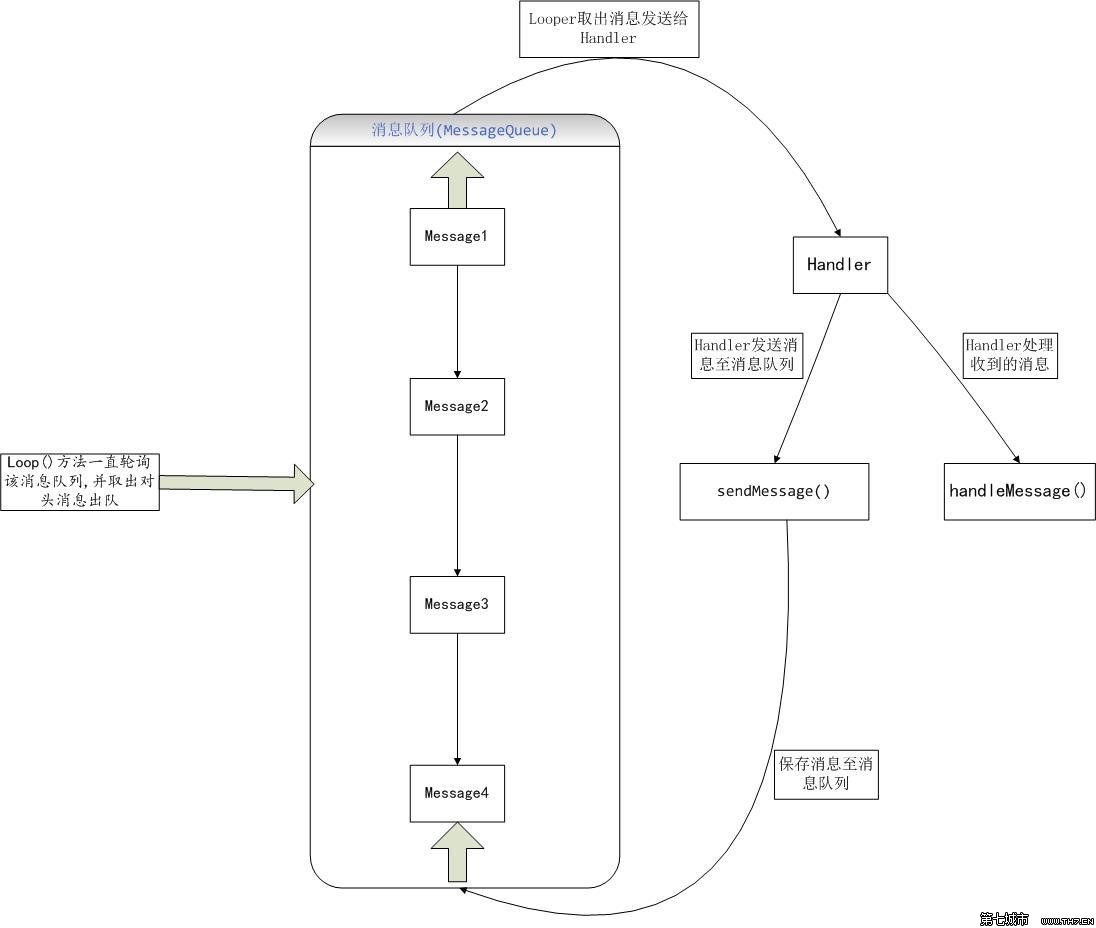目录
(4)为什么使用handler,MessageQueue,Looper?
(5)Android为什么要设计只能通过Handler机制更新UI呢?
Q1:用一句话概括Handler,并简述其原理?
(1)Handler是什么?
Handler通常被我们用来做主线程与子线程之间的通信工具,它的应用非常广泛,可以说只要有异步线程与主线程通信的地方就一定会有 Handler。
(2)Handler的原理是什么?

andriod提供了Handler 和 Looper 来满足线程间的通信。Handler先进先出原则。Looper类用来管理特定线程内对象之间的消息交换(MessageExchange)。
- 1)Looper: 一个线程可以产生一个Looper对象,由它来管理此线程里的MessageQueue(消息队列)。
- 2)Handler: 你可以构造Handler对象来与Looper沟通,以便push新消息到MessageQueue里;或者接收Looper从Message Queue取出)所送来的消息。
- 3) Message Queue(消息队列):用来存放线程放入的消息。
- 4)线程:UIthread 通常就是main thread,而Android启动程序时会替它建立一个MessageQueue。
(3)Handler有什么作用?
- 更新UI
- 发送消息
- 处理消息
(4)为什么使用handler,MessageQueue,Looper?
主线程无法进行时间比较繁长的任务,所以需要子线程进行处理,然而子线程无法进行UI的界面更新,所以我们需要使用handler来传递消息给主线程,让其完成UI的更新。由于主线程和子线程进行不同的时间工作,所要需要用MessageQueue来存放子线程的消息,Looper取出消息交给主线程响应。
(5)Android为什么要设计只能通过Handler机制更新UI呢?
最根本的目的就是解决多线程并发问题。
假如在一个Activity当中,有多个线程去更新UI,并且都没有加锁机制,那么会产生什么样子的问题?
答案是:更新界面错乱。
如果对更新UI的操作都进行加锁处理的话又会产生什么样子的问题?
答案是:性能下降。
出于对以上问题的考虑,android给我们提供了一套更新UI的机制,我们只需要遵循这样的机制就行了,而根本不用去关心多线程问题,所有的更新UI的操作,都是在主线程的消息队列当中去轮询处理的。
(6)Handler怎么用?
- sendMessage
- sendMessageDelayed
- post(Runnable)
- postDealyed(Runnable,long)
(7)Android中更新UI的几种方式:
- runOnUIThread
- handler post
- handler sendMessage
- view post
(8)使用Handler时候遇到的问题?
- android.view.ViewRootImpl$CalledFromWrongThreadException:Only the original thread that created a view hierarchy can touch its views. 只有原生线程才能更新UI。
- Can't create handler inside thread that has not called Looper.prepare().
(9)谷歌官方开发文档中关于对Handler的介绍:
A Handler allows you to send and process Message and Runable objects associated with a thread's MessageQueue. Each Handler instance is associated with a single thread and that thread's message queue. When you create a new Handler, it is bound to the thread/message queue of the thread that is creating it-- from that point on, it will deliver message and
runnables to that message queue and execute them as they come out of the message queue.
翻译:一个Handler允许你发送和处理跟一个Thread的MessageQueue相关的Message和Runable对象。每个Handler实例都跟一个单独的Thread以及该Thread创建的MessageQueue相关。当你创建一个Handler的时候,这个Handler就跟一个Thread以及该Thread创建的MessageQueue绑定在一起,所以,这个Handler将会传递messages和runnables给那个MessageQueue,并且处理来自这个MessageQueue的messages和runnables。
解释:我们创建一个Handler的时候,它会跟一个默认的Thread绑定,这个默认的Thread中就有一个MessageQueue(消息队列)。
When a process is created for your application, its main thread is dedicated(专用于) to running a message queue that takes care of managing the top-level application objects(activities,broadcast receivers .etc) and any windows they create.You can create you own threads, and communicate back with the main application thread through a Handler. This is done by calling the same post or sendMessge methods as before,but from your new thread. The given Runnable or Message will then be scheduled(列入计划表) in the Handler's message queue and processed when appropriate(适当的时候).
当我们创建一个application的时候,它就会自动创建一个process(进程),这个process的main thread(即application的主线程,也是UI线程)是一个ActivityThread,main thread会默认创建一个Looper,这个Looper就和主线程及其MessageQueue产生了联系。这个main thread 专门用来运行一个message queue,这个message queue用于管理顶级的application对象(例如activities,broadcast receivers等)和它们创建的windows。你也可以创建自己的threads,这些threads可以通过Handler的post or sendMessge methods跟main thread联系。给定的Runnable or Message将会被放入message queue ,并且在合适的时候会被处理。





















 3万+
3万+











 被折叠的 条评论
为什么被折叠?
被折叠的 条评论
为什么被折叠?








